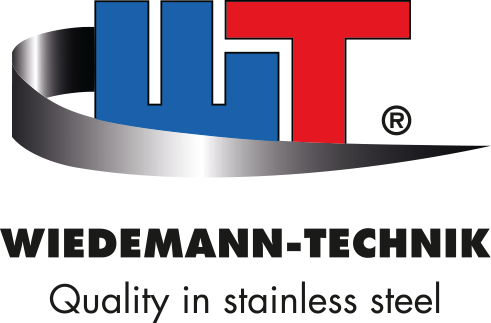Corrosion resistance
Stainless steel contains alloy components that form a passive film on the material surface. This film is only a few atoms thick and is continuously renewed, using oxygen from the air or from water. This passive film can only form on bright surfaces that are free of dirt and deposits.
Basic cleaning
Normally, the products are cleaned thoroughly by the operator before they are commissioned on site.
In many cases, the stainless steel surfaces are protected during transport, storage, assembly and installation with a plastic foil. This foil is, however, not UV-proof and might be difficult to remove after having been exposed to light for a prolonged period of time. In some cases, it might be impossible to remove the foil from sections of the material at that stage. We therefore recommend removing the protective foil as soon as this protection is no longer required, or, at the latest, one week after delivery of the product. Remove the foil by pulling it from the top down. To eliminate any deposits or residues that might prevent the formation of the passive film, clean the surfaces with warm water and a mild detergent.
Plaster and mortar residue can be removed with a diluted phosphoric acid. Subsequently rinse the surface with plenty of clean water. Water stains and limescale deposits can be prevented by cleaning the surface with deminineralised water.
Various detergent and care product manufacturers offer special products for the treatment of stainless steel. Never use diluted hydrochloric acid or cement scum remover for tiles. Should such substances have been spilled by accident onto stainless steel surfaces, remove them without delay by rinsing the surface with plenty of clean water.
Other subcontractors such as tilers working on the site might not always be aware of the damage that scum removers and hydrochloric acid can do to stainless steel.
Iron chips and particles from tools, scaffolding or transport gear must be removed without delay. Grinding dust, chips and weld spatter arising from work carried out near the stainless steel unit can cause accelerated corrosion. They might penetrate the passive film layer of the stainless steel, causing spot corrosion.
If such dirt on the surface is detected on time, it can be removed with conventional (ferrite-free) scouring pads or a special cleaning product. Subsequently rinse the surface with plenty of clean water, which enables the material to restore its passive film.
If corrosion has already occurred, it can only be removed mechanically or (preferably) by pickling. Pickling agents for local application are available in paste form. When using such products, strictly follow the safety and environmental protection instructions of the manufacturer. Alternatively, have the surface restored by a specialist company who will perform this task on site.
After pickling, the corrosion resistance of stainless steel is fully restored. The treated area might, however, remain visible, so that the entire stainless steel surface needs to be ground or polished. To prevent contamination with iron particles, we strongly recommend leaving the surface covered, or to install the stainless steel components only after all other constructive steel work in the vicinity is completed.
Routine cleaning
Stainless steel components that are installed outdoors are normally kept clean by rain, which prevents damaging deposits. Areas that are not reached by rain should be regularly cleaned to remove any deposits arising from air pollution. Units that are installed near coasts or in industrial areas with high concentrations of chloride and sulphur dioxide need to be cleaned more frequently, as the steel grade might not be suitable for such high impact. Please note that chloride and sulphur dioxide deposits can also occur at the bottom side of
horizontal profiles.
Units installed inside a building are normally better protected. The main problem here are fingerprints that need to be removed regularly. Stainless steel is available with a range of finishes, including special finishes designed for surfaces that are frequently touched, for example in public areas. By choosing a suitable material during the planning phase, cleaning costs can be significantly reduced.
On brushed and ground surfaces, which have become very popular, fingerprints are only visible during a short initial phase after installation. They become less and less visible as the surface is regularly cleaned.
Detergents
Fingerprints can be removed using washing-up liquid. A number of detergent manufacturers offer special products that contain substances designed to protect the surface after cleaning. These products remove all fingerprints and leave behind a thin film that gives the surface a uniform sheen. After application, polish the surface with a dry cloth. Bright annealed and mirror-polished surfaces can be cleaned with a chloride-free glass cleaner.
Persistent deposits are best treated with a conventional opaque detergent that also removes limescale and slight discolouration. Subsequently rinse the surface with clean water. Final rinsing with demineralised water (available in supermarkets, for example, for irons) prevents the formation of water stains. After cleaning and rinsing, wipe the surface dry. Do not use abrasive detergents, as they cause damage to the stainless steel surface.
Greasy or oily dirt can be removed with an alcohol-based detergent or solvent, such as white spirit, isopropyl alcohol or acetone, which do not cause damage to stainless steel. Ensure, however, that, during cleaning, the dissolved particles are not spread over a larger surface area. To remove all traces of the dirt, use a number of clean cloths to take up all dissolved particles.
Paint residue and graffiti can be removed with special alkaline or solvent-based detergents. Do not attempt to remove paint mechanically with a blade or scraper, as this would damage the metal surface.
Stainless steel surfaces that have not been properly cleaned for a long time might be treated with a polish, such as a chrome polish used for cars. If necessary, you might use a car polishing paste. This must, however, be done with great caution, as such products scratch the metal surface.
Another recommended alternative are special stainless steel cleaners containing phosphoric acid (see above instructions for the removal of iron dirt). To prevent stains, treat the entire stainless steel surface with the cleaner.
Always strictly adhere to the use, safety and environmental instructions of the product manufacturer.
Detergents that are not suitable for use on stainless steel:
- Products containing chloride or hydrochloric acid
- Bleach (if accidentally spilled onto stainless steel, rinse
- surface thoroughly with plenty of clean water)
- Silver polish
Cleaning utensils
Fingerprints can normally be removed with a damp cloth or chamois leather.
For more persistent dirt, use a conventional, non-ferrite scouring pad. Never use ferrite scouring pads, steel wool, or a steel brush, as they leave behind iron particles that destroy the stainless steel passive film.
Rolled pattern surfaces can best be cleaned with a soft nylon brush. Steel brushes (including brushes made from carbon steel) cause damage to stainless steel.
Brushed and ground surfaces (2G, 2J, 2K according to DIN 10088/3) should always be wiped in the direction of the grinding pattern.
After cleaning with water, the surfaces must be wiped dry to prevent water stains caused by minerals in the water. This is particularly important in areas with hard water. Water stains can be prevented by using demineralised water.
To prevent damage from foreign iron, do not use cleaning utensils that have been used on „normal“ steel. We strongly recommend keeping a set of special cleaning utensils that are only used for stainless steel surfaces.
Cleaning intervals
The cleaning intervals for indoor stainless steel surfaces are generally in line with those for other surfaces. To keep costs and effort to a minimum, we recommend cleaning surfaces before persistent deposits have formed.
Stainless steel used in outdoor installations might be exposed to corrosive substances, e.g.:
- Coastal air
- Industrial emissions
- Spray water containing road salt
- Vehicle and general flue emissions
Over time, exposure can cause discolouration, which can, however, be effectively removed with a detergent containing phosphoric acid.
As a rule of thumb, we recommend cleaning stainless steel surfaces that are exposed to corrosive ambient air or that are highly visible at the same intervals as glass surfaces. Surfaces that are regularly washed down by rain and are not exposed to a corrosive atmosphere need only to be cleaned every few years. Surfaces in outdoor installations that are not reached by rain must be cleaned every few months.
Source
Advice sheet 965 – Reinigung und Pflege von Edelstahl-Rostfrei im Bauwesen
(Standard cleaning and care practices for stainless steel in construction projects)

